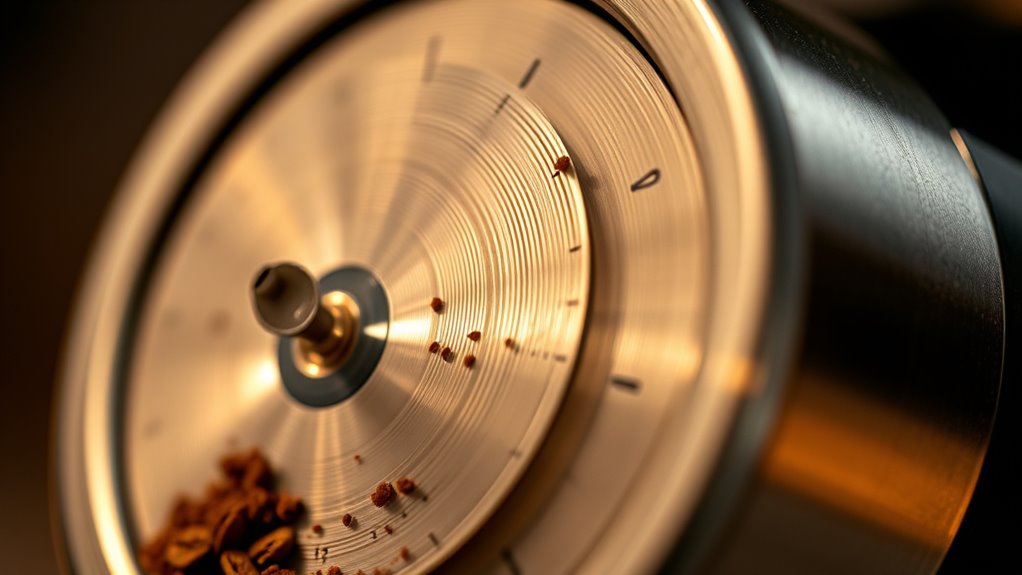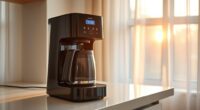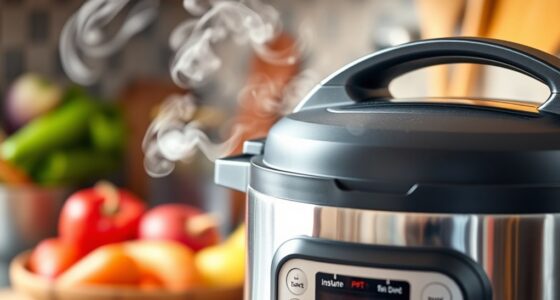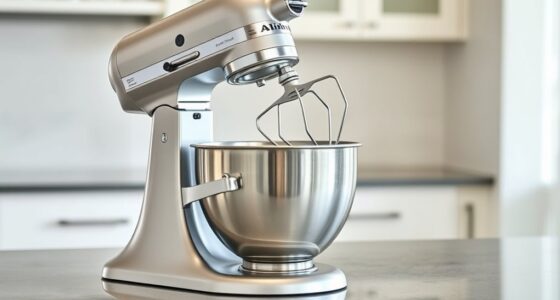Adjusting your burr grinder’s settings by just a few microns can make a big difference in your coffee’s flavor and aroma. Finer settings (lower micron values) extract more bold flavors, while coarser settings (higher micron values) produce lighter, brighter brews. Proper calibration guarantees consistent grind size, which is key to balancing extraction and flavor. Small tweaks matter more than you think—if you want to discover the full impact, the details are worth exploring further.
Key Takeaways
- Grind size in microns directly influences extraction rate and flavor clarity; precise calibration ensures optimal taste.
- Small adjustments in burr settings, measured in microns, can significantly alter brew strength and flavor profile.
- Proper calibration at specific micron levels aligns grind size with brewing method, enhancing aroma and balance.
- Consistent microns in grind size prevent over- or under-extraction, resulting in more uniform and desirable flavors.
- Regularly measuring and adjusting burrs in microns maintains flavor consistency and maximizes coffee quality over time.

Choosing the right grind setting on your burr grinder is essential for brewing the perfect cup of coffee. The grind size you select directly impacts extraction, flavor, and overall quality. Getting this right means understanding how to fine-tune your burr calibration and guarantee consistent grind size. When your burrs are properly calibrated, they produce a precise and uniform grind, which is vital because grind consistency affects how water interacts with coffee grounds during brewing. If your burrs are misaligned or not calibrated correctly, you’ll end up with uneven particle sizes, leading to over-extraction or under-extraction, both of which ruin the taste.
Burr calibration is the process where you adjust the burrs to achieve the desired grind size. This step is critical because even small misalignments can cause significant differences in grind size, especially when aiming for a specific brew method. For example, espresso requires a much finer grind than French press, and a slight shift in burr calibration can make the difference between a balanced shot and a bitter or weak one. Regular calibration ensures your grinder consistently produces the intended grind size, maintaining grind consistency across different batches. This consistency is key to replicating your ideal flavor profile time and again.
Grind consistency plays a critical role in flavor development. When your burr grinder produces uniform particles, water extracts flavors evenly, resulting in a balanced and full-bodied coffee. On the other hand, inconsistent grind sizes lead to uneven extraction; finer particles tend to over-extract, becoming bitter, while larger particles under-extract, tasting sour or bland. By paying close attention to burr calibration and maintaining grind consistency, you can fine-tune your brewing process to optimize flavor. This might mean adjusting your grinder settings slightly to match your preferred brewing method or tweaking the calibration periodically to account for wear and tear on the burrs. Additionally, using a high-quality burr grinder ensures better grind uniformity, which is essential for consistent flavor.
Furthermore, understanding how different grind sizes affect extraction helps you make smarter adjustments. For example, a coarser grind is better for French press or cold brew, while a medium to fine grind suits drip coffee or AeroPress. Once you master burr calibration and achieve consistent grind sizes, you’ll notice a marked improvement in your coffee’s clarity, aroma, and overall taste. It’s worth investing time in these adjustments because they serve as the foundation for brewing excellence. When your grind is just right, and your burrs are properly calibrated, you release the full potential of your beans, leading to a more enjoyable coffee experience every time.
Frequently Asked Questions
How Do Grind Settings Affect Brew Time?
You might wonder how grind settings influence brew time. When you use a finer grind size, the water takes longer to pass through the coffee, increasing brew time. Conversely, a coarser grind allows water to flow faster, reducing brew time. Adjusting your grind setting lets you control brew time, ensuring your coffee extracts properly for ideal flavor. So, pay attention to grind size to get your desired brew speed and taste.
Can Changing Grind Size Improve Coffee Acidity?
Yes, changing your grind size can improve coffee acidity. A finer grind increases surface area, extracting more bright, acidic flavors, while a coarser grind reduces acidity. To get consistent results, focus on grind size consistency, which ensures even extraction. Also, using fresh beans enhances acidity, as older beans lose their vibrant flavor. Adjusting your grind size thoughtfully helps you fine-tune acidity and achieve a balanced, flavorful brew.
Are There Universal Grind Settings for All Beans?
Trying to find universal grind settings is like chasing a rainbow — impossible! Bean varietals and roast levels dramatically influence the perfect grind. You need to adjust for each bean’s unique characteristics to achieve ideal flavor and grind consistency. No single setting fits all beans because their sizes, densities, and flavors vary. So, experiment with different settings to reveal the best taste for each batch.
How Often Should I Recalibrate My Grinder?
You should recalibrate your grinder whenever you notice inconsistencies in your brew or after changing beans. Regular calibration helps maintain consistency, ensuring your grind size stays precise for ideal flavor. Typically, recalibrate every few weeks or monthly, depending on usage. Keep an eye on grind quality, and don’t hesitate to recalibrate if you switch beans or if your results start to vary. Consistent calibration is key to great coffee.
Do Grind Settings Impact Coffee Aroma Significantly?
Your coffee’s aroma is as delicate as a whisper, and grind size consistency plays a huge role in preserving it. When you adjust your grind settings, even slightly, it can dramatically alter the aroma’s intensity and complexity. Precise grind settings guarantee uniform extraction, revealing the full potential of your beans’ aroma. So yes, grind settings impact aroma significantly—small tweaks can turn a good brew into an unforgettable sensory experience.
Conclusion
Remember, your grind setting is the brushstroke that shapes your coffee’s masterpiece. Like a delicate sculpture, each micron tweak reveals hidden flavors and nuances, transforming a simple brew into a sensory journey. Don’t settle for the surface—dive deep into the details, and let your precision carve out the perfect cup. With every adjustment, you’re painting a richer, bolder flavor picture—so keep honing those settings and savor the masterpiece you create.









